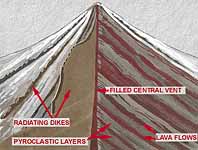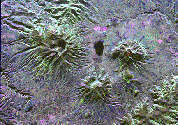
Stratovolcanoes, also known as composite cones, are the most picturesque and the most deadly of the volcano types. Their lower slopes are gentle, but they rise steeply near the summit to produce an overall morphology that is concave in an upward direction. The summit area typically contains a surprisingly small summit crater. This classic stratovolcano shape is exemplified by many well-known stratovolcanoes, such as Mt. Fuji in Japan, Mt. Mayon in the Philippines, and Mt. Agua in Guatemala.

|

|
|
|
|
In detail, however, stratovolcano shapes are more variable than these classic examples, primarily because of wide variations in eruptive style and composition. Some may contain several eruptive centers, a caldera, or perhaps an amphitheater as the result of a lateral blast (e.g., Mt. St. Helens).
 Typically, as shown in the image to the left, stratovolcanoes
have a layered or stratified appearance with alternating lava
flows, airfall tephra, pyroclastic
flows,
volcanic mudflows (lahars),
and/or debris flows. The compositional spectrum of these rock
types may vary from basalt to rhyolite in a single volcano; however,
the overall average composition of stratovolcanoes is andesitic.
Many oceanic stratovolcanoes tend to be more mafic than their
continental counterparts. The variability of stratovolcanoes is
evident when examining the eruptive history of individual volcanoes.
Mt. Fuji and Mt. Etna,
for example, are dominanted by basaltic lava flows, whereas Mt.
Rainier is dominated by andesitic lava, Mt. St. Helens by andesitic-to-dacitic
pyroclastic material, and Mt. Lassen by dacitic lava domes.
Typically, as shown in the image to the left, stratovolcanoes
have a layered or stratified appearance with alternating lava
flows, airfall tephra, pyroclastic
flows,
volcanic mudflows (lahars),
and/or debris flows. The compositional spectrum of these rock
types may vary from basalt to rhyolite in a single volcano; however,
the overall average composition of stratovolcanoes is andesitic.
Many oceanic stratovolcanoes tend to be more mafic than their
continental counterparts. The variability of stratovolcanoes is
evident when examining the eruptive history of individual volcanoes.
Mt. Fuji and Mt. Etna,
for example, are dominanted by basaltic lava flows, whereas Mt.
Rainier is dominated by andesitic lava, Mt. St. Helens by andesitic-to-dacitic
pyroclastic material, and Mt. Lassen by dacitic lava domes.
Stratovolcanoes typically form at convergent plate margins, where one plate descends beneath an adjacent plate at the site of a subduction zone. Examples of subduction-related stratovolcanoes can be found in many places in the world, but they are particularly abundant along the rim of the Pacific Ocean, a region known as Ring of Fire. In the Americas, the Ring of Fire includes stratovolcanoes forming the Aleutian islands in Alaska, the crest of the Cascade Mountains in the Pacific Northwest, and the high peaks of the Andes Mounains in South America. A satellite view of three stratovolcanoes from the Andes is shown here:

|
Three Andean stratovolcanoes in northern Ecaudor |
The eruptive history of most stratovolcanoes is delineated by highly explosive Plinian eruptions. These dangerous eruptions are often associated with deadly pyroclastic flows composed of hot volcanic fragments and toxic gases that advance down slopes at hurricane-force speeds. Like shield volcanoes, stratovolcanoes are polygenetic; however, they differ from shield volcanoes in that they erupt infrequently, with typical repose intervals of hundreds of years between eruptions. Most active stratovolcanoes worldwide appear to be < 100,000 years old, although some, like Mt. Rainier, may be more than 1 million years old.
Go to: